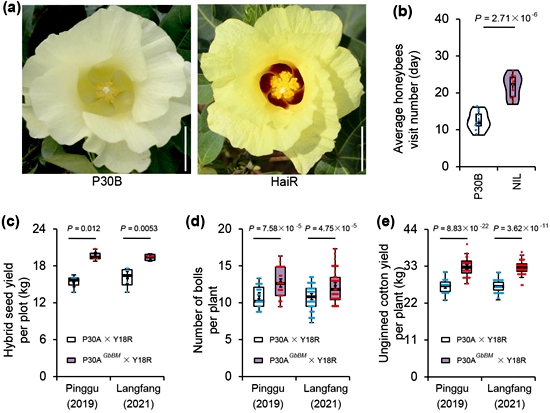Discovery of Transcription Factor MYB113 Responsible for the Development of Cotton Petal Spot and its Reinforcement for Cross-fertilization Efficiency by Attracting Honeybees as Pollinator
The scientists of the Crop Molecular Breeding Laboratory in Biotechnology Research Institute, Chinese Academy of Agricultural Sciences (BRI, CAAS) have retrieved the lost G. hirsutum petal spot to attract pollinators visiting for reinforcement cross-fertilization efficiency in cotton hybrid seed production. This applied research has improved the pollination efficiency by insect pollinators increase 14% yield of hybrid seed cotton. Gene encoding a R2R3 type MYB113 protein was identified via large F2 intraspecific population of G. hirsutum and G. barbadense followed by development of CRISPR/Cas9 knock out/in mutants revealed MYB113 a key gene regulating development of purple petal spot in G. barbadense (Figure 1). Since this purple spot resembled a purple beauty mark, so designated the underlying genetic locus in G. barbadense as Beauty Mark (BM). Relevant results of this study were published in Plant Biotechnology Journal.

Figure 1 Identification and functional validation of GbBM
In order to increase the effectiveness of cross-pollination in cotton, cotton varieties with flowers appealing to pollinators should be the goal of genetic improvement in the cotton industry. Here in this study, firstly the genetic basis underlying formation of the purple spot at the base of cotton floral petals was mapped using large segregating population leading followed by expression analysis led to identification of GbBM. GbBM gene was knocked down and knocked out by virus induced gene silencing and CRISPR/Cas9, results indicated that GbBM is causal gene responsible for the petal spot phenotype. Sequence variation analysis classified BM gene allelic variations into two haplotypes: one with beauty mark varieties (haplotype GbBM) and one without beauty mark varieties (haplotype GhBM). BMpromoter-LUC assays showed no significant differences in luciferase (LUC) activity between the GbBMpromoter-LUC and GhBMpromoter-LUC constructs. By contrast, LUC activity was obviously increased by transient expression of the GbBM CDS reporter construct, whereas GhBM reduced LUC activity. A yeast one-hybrid analysis showed that GbBM directly bind to and activate the promoters of GbCHS, GbDFR, GbANS, GbUFGT, or GbFLS, respectively. And chromatin immunoprecipitation with quantitative PCR (ChIP-PCR) assays revealed significant enrichment for GbCHS, GbDFR, GbANS, and GbFLS promoter fragments containing the MYB core motifs.
Thus, the R2R3-MYB TF protein GbBM functions is specifically expressed in flower petal beauty mark region and functions as a positive transcriptional regulator of flavonoid biosynthesis genes. Further to give biological significance it was found that beauty mark phenotype promotes the frequency of honeybee visitation with experiments wherein honey bees were offered a choice between NIL and P30B flowers. This approach can be harnessed to reduce costs and increase the efficiency of cotton hybrid seed production, which can ultimately promote the broader adoption of elite, high-yield hybrid cotton lines.
Muhammad Ali Abid, a Post-Doctoral Researcher at the BRI, CAAS is the first author; Wei YunXiao (Assistant Professor) is the co-author of the paper. Liang Chengzhen (Professor) and Zhang Rui (Professor) of BRI of CAAS, and Chengcai Chu (Professor) of Institute of Genetics and Developmental Biology of the Chinese Academy of Sciences are the co-corresponding authors. This research was supported by the Ministry of Agriculture of P.R. China, National Key Basic Research Program, The Agricultural Science and Technology Innovation Program of CAAS, National Natural Science Foundation of China.
By Liang Chengzhen (liangchengzhen@caas.cn)
-
 Apr 18, 2024Opening Ceremony of the Training Workshop on Wheat Head Scab Resistance Breeding and Pest Control in Africa Held in CAAS
Apr 18, 2024Opening Ceremony of the Training Workshop on Wheat Head Scab Resistance Breeding and Pest Control in Africa Held in CAAS -
 Apr 03, 2024IPPCAAS Co-organized the Training Workshop on Management and Application of Biopesticides in Nepal
Apr 03, 2024IPPCAAS Co-organized the Training Workshop on Management and Application of Biopesticides in Nepal -
 Mar 28, 2024Delegation from the School of Agriculture and Food Science of University College Dublin, Ireland Visit to IAS, CAAS
Mar 28, 2024Delegation from the School of Agriculture and Food Science of University College Dublin, Ireland Visit to IAS, CAAS -
 Mar 25, 2024Director of World Food Prize Foundation visited GSCAAS
Mar 25, 2024Director of World Food Prize Foundation visited GSCAAS -
 Mar 20, 2024Institute of Crop Sciences (ICS) and Syngenta Group Global Seeds Advance Collaborative Research in the Seed Industry
Mar 20, 2024Institute of Crop Sciences (ICS) and Syngenta Group Global Seeds Advance Collaborative Research in the Seed Industry
